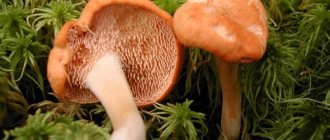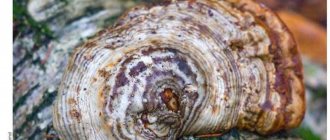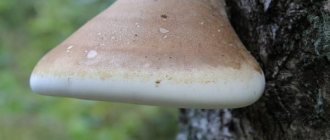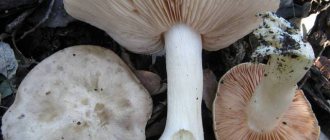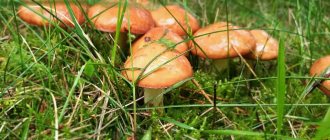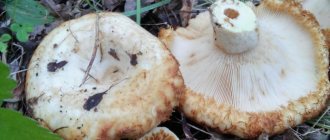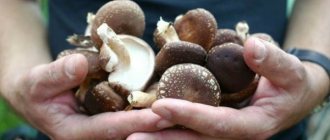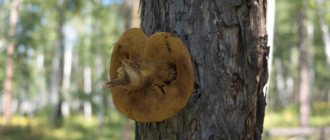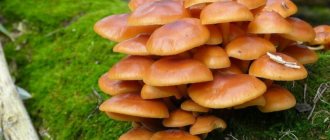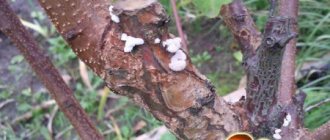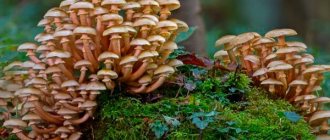False polypore (Phellinus igniarius) - description and photo. Features of the false tinder fungus, its differences from other tinder fungi. Possible use of tinder fungus for medicinal purposes.
Hello dear reader!
This tinder fungus can be called “false” only in the sense that it is in no way related to another widespread tinder fungus - the true tinder fungus (Fomes fomentarius).
The name “tinder” has long become a convention, a tribute to tradition. Mushrooms called by this name belong not only to different genera, but even to different families of the mushroom kingdom.
The false polypore is a representative of the genus Phellinus (Phellinus) from the Phellinaceae family. The mushroom is widespread in the forests of the Northern Hemisphere.
False tinder fungus on a birch tree
Systematics, characteristics and description of the structure
Pyptoporus or tinder fungus is also called birch sponge or tinder fungus. It goes by the Latin name Placodes betulinus or Piptoporus betulinus. There are many Latin synonyms: Agarico-pulpa pseudoagaricon, Agaricum conchatum, Boletus betulinus, Boletus suberosus, Fomes betulinus, Ungularia betulina. The fruit belongs to the genus Piptoporus of the Fomitopsis family.
The hat reaches 20 cm in diameter, thickness - no more than 6 cm. It has a spherical shape, then gradually takes on the shape of a horseshoe. The surface color is gray-brown, the edge is thick.
The hymenophore (cap below) is tubular, white, later acquiring gray and brown shades. The tubes are round, sometimes angular, up to 5 mm long. The spores have no color.
The pulp is white and does not change color when cut. The taste is bitter, the aroma of mushroom is quite strong.
Mushrooms that grow on birch trees. Medicine
Medicinal properties were discovered in ancient times. The keratinized skin was removed from whole fruits and disinfected.
Beneficial substances contained in the pulp help with weight loss:
- weaken appetite;
- have a diuretic effect;
- treat constipation and cleanse the intestines.
A general stimulating effect on the body is also noted. During the cold season, the tincture will strengthen the immune system, improve overall mood and emotional background.
Medicinal tinctures and rubs from birch polypore are used for joint diseases and wound treatment. The pulp contains natural anti-inflammatory substances. Cut strips of the fruit are used as a plaster for small open wounds.
In medicine, the following is obtained from the fruiting body:
- Polysaccharides that serve as the basis for experimental drugs for oncology.
- An extract (or extract) that has an anti-inflammatory effect and works as a pain reliever.
- Chitin and pectin, which are used to make colon cleansing drugs and nutritional supplements.
- Laboratory-produced polyporenic acid. It is part of medications against ulcers and inflammation of the gastrointestinal tract.
- Some substances. They are useful for the functioning of the liver and kidneys, helping to cope with infiltrates.
- Powder made from ground pulp. It is a good antiseptic for wounds and promotes healing.
All preparations and tinctures are obtained only from safe polypores on birch. False subspecies and chaga are not used for medicinal purposes. Specimens collected in places of contamination are also not used.
Chaga, or birch mushroom, belongs to the representatives of the polypore family. It is a perennial growth of irregular shape on the bark of a tree.
It can reach 0.5 meters in length. Chaga mainly parasitizes the trunks of adult birches, but it can also be found on other deciduous trees - aspen, alder, rowan, elm and beech.
Only the chaga that grows on birch and feeds on its juices has a medicinal effect. Hence the name birch mushroom.
The outer surface of chaga is dark, almost black, covered with many cracks, and the inner surface is brown, with lighter veins at the base. Due to its dense structure, the weight of the mushroom can reach 5 kg. Cutting it from a tree is not so easy. To do this, you will have to use an ax, or, in the absence of one, a large sharp knife. The birch chaga mushroom grows very slowly. It reaches medium size after about 10 years.
The favorite places for the fungus on trees are damaged areas of bark, twigs and broken branches. Despite the fact that chaga is a parasitic mushroom, it can safely be called a forest orderly. After all, she chooses only old or damaged trees as a place of residence and almost never settles on healthy ones.
Features of collection, time and place of fruiting
It grows in most cases on dead birch trees, causing yellow-brown or red-brown rot to appear on the tree trunk. It develops actively and causes destructive effects.
The birch quickly withers and becomes rotten. The infection begins at the root of the tree, then gradually spreads throughout the entire trunk. The greatest distribution of the fungus was recorded in Western Siberia.
Interesting! It is believed that young, unhardened fruiting bodies can be eaten; they have not acquired any bitterness, and their flesh is quite soft. Birch polypore is not poisonous. They are prepared by cutting them into thin slices.
It is believed that the birch tinder fungus grows throughout Russia, where there are birch trees, with the exception of the taiga and tundra. Fruiting occurs from early summer and ends in late autumn.
Throughout the entire period of growth, the birch tinder fungus can be collected: it is carefully separated from the tree, and before harvesting, the lower part or hymenophore is removed.
If a crust has already appeared on the cap, then it is also removed. The preparation is made on the day of collection, they are dried quickly, then tinctures are prepared from them, which are stored in the refrigerator.
What damage do tinder fungi cause to trees?
The tinder fungus almost does not affect healthy birch trees. In most cases, it develops on dead wood, already fallen or cut down trees, as well as on sick, damaged or weakened specimens. Wood affected by tinder fungus loses its density, brown rot develops in it, which progresses rapidly. In a short time, the tree completely loses its mechanical properties, becomes rotten and unsuitable for any business use.
By autumn, tinder fruiting bodies appear on the bark. After its tubular layer matures, spores begin to pour out of it, which are carried by rainwater and wind. This in turn will lead to infection of other birch trees growing in the immediate area if they are sick or weak.
Despite the seemingly obvious harm to trees, the tinder fungus cannot be unambiguously classified as a parasitic fungus; to a greater extent, it is still a saprotroph. He can be considered as a kind of forest orderly, ridding plantings of dead and diseased wood. The hyphae of the tinder fungus quickly decompose cellulose into simpler substances, thereby facilitating the rapid processing of wood into easily digestible organic fertilizer. In addition, birch sponge has medicinal properties and can bring considerable benefits.
Infusion and decoction of this mushroom are used in folk medicine to treat various diseases, such as:
- Sinusitis.
- Gastrointestinal diseases.
- Food poisoning.
Important! According to some reports, an infusion of tinder fungus can stop the growth of cancer cells.
A short video about the beneficial qualities of this mushroom:
Why is the fungus dangerous for birch trees and measures to combat it?
The fungus is considered a parasite that prefers birch trees. Weakened trees are affected, losing up to 50% of their mass in just 4 months.
Rot develops very actively, the most preferred temperature for growth is +25 degrees, but bodies are able to develop safely down to -5 0C.
If a fungus has already appeared on a birch tree, the tree will not survive; it is almost impossible to remove the tinder fungus. The simplest option is to remove the diseased plant.
If you want, you can try to cure it, but it will take a lot of time and patience. To do this, it is necessary to constantly cut off the fruiting bodies and disinfect the places where they appear.
Interesting! After the “work” of the tinder fungus, the wood turns into high-quality humus.
Causes of damage to birch trees by tinder fungi
In most cases, the tinder fungus living on birch behaves like a saprotroph, using already dead organic matter for its development. It parasitizes living trees quite rarely, appearing only on old and diseased birch trees. There may be several reasons for the appearance of birch polypore on a living tree:
- The tree is weakened as a result of mechanical damage.
- There are fungal diseases of the bark, moss, and lichen.
- Depressed state as a result of damage to roots, flooding.
- The tree is weakened by drought or other natural factors.
Dead wood is an excellent breeding ground for the development of tinder fungus
Important! The birch sponge reproduces especially rapidly in places where there are a large number of fallen trees, as well as on birch trees growing in flooded areas.
False doubles
Polypores are generally similar to similar species; they can be easily distinguished if you are careful when collecting them. Before you go on a quiet hunt, you need to carefully study the photo.
| Name | Fruiting body | Place of growth | Edibility |
| Birch polypore | Resembles a huge brown kidney | Birches | Inedible |
| Oak polypore | Round or fan-shaped, may have a small stalk, velvety, brown, yellowish | Oak | Inedible |
| Chaga | Externally it resembles a growth on a tree, the color is black, the inside is dark brown | Birches | Inedible |
| False tinder | Hoof-shaped, attached to the tree very tightly, very hard, rusty or brown-chestnut color | Found on any tree | Inedible |
| Fox tinder | Bright orange, pubescent when young | Aspen, less often on other larches | Inedible |
All tinder fungi are inedible, but most of them have found their use in folk and official medicine. When preparing yourself, extreme caution should be used.
Signs of tinder fungus damage
Since the mycelium of the tinder fungus develops inside the tree, it is very difficult to detect primary signs of infection on a living birch. The fruiting bodies of tinder fungi growing on trees are found on the trunk or branches only in the fall, in the last stage of infection, when all the wood is already infected with mycelium. If you make a transverse cut of a tree during this period, the affected area will be visible on it in the form of a ring-shaped area of a reddish color, turning into red-brown or brown.
Ring rot is a sign of infection
The appearance of the fruiting bodies of the tinder fungus on the birch trunk indicates that the process is already irreversible, and decomposition is already underway inside the tree. The liquid secreted by the hyphae of the birch sponge destroys the cellulose that makes up the wood, turning it into simpler nutrients that can be absorbed by the tinder fungus. As it grows, the birch trunk loses strength, becoming more and more rotten. Under such conditions, various insects and their larvae begin to rapidly develop in the wood, and after them come the birds that feed on them. Numerous punctures in the bark and hollows made by bird beaks indicate that life is in full swing under the birch bark layer.
Gradually, the wood of the birch trunk becomes more and more loose. When struck, it stops making the ringing sound characteristic of living trees, the knocking becomes more and more muffled, and the trunk itself begins to collapse. In the end, the tree completely loses its properties, literally turning into dust. The birch trunk can remain in an upright position for some time, supported by birch bark that is denser and not subject to rotting, but it subsequently falls to the ground under the influence of the wind or under its own weight.
The dead birch tree will soon fall from the wind
Important! It can take several years from the moment a birch tree is infected with spores of the tinder fungus until the tree is completely destroyed.
Edibility, medicinal properties, benefits and contraindications
Birch tinder fungus is an inedible mushroom; the bitterness of its pulp does not go away even after heat treatment, and the pulp is so hard that it is impossible to chew it.
It is not used for food, but numerous studies predict a great future for the tinder fungus, having discovered in its body a huge amount of useful substances that can fight various diseases.
For external use, the mushroom is contraindicated in the presence of allergies or individual intolerance. It should not be used in any form by children, the elderly, pregnant and lactating women, as well as for chronic joint diseases and skin eczema of various etiologies.
How to deal with tinder fungi
If a tree is infected with birch sponge, then it will no longer be possible to save it. It is better to cut down and burn a diseased birch tree. To prevent further spread of fungal spores, all fruiting bodies must also be cut off and burned. In some cases, tinder fungi may appear not on the birch trunk, but on one of the large side branches, especially if it has been broken or damaged. In this case, there is a chance that the tree can be saved if the mycelium has not had time to penetrate into the deep tissues. The branch must be cut off from the trunk and burned along with the fruiting bodies of the tinder fungus.
Wood affected by tinder fungus must be burned
Important! Damaged branches must be removed before the fruiting bodies of the tinder fungus ripen, otherwise spores will spill out of them and the infection will continue.
Chemical composition and use in folk medicine
The mushroom contains an anti-inflammatory substance - polyporenic acid, which is compared in strength to cortisone, a large amount of proteins and carbohydrates, as well as fiber, B vitamins, resins, selenium, potassium and zinc, phosphorus and manganese.
Birch polypore is often used by folk healers; infusions and decoctions can be prepared from it, which can help cope with various diseases.
The mushroom is popular for treating:
- obesity, helps reduce excess weight;
- constipation;
- immunity, increases resistance to various diseases, improves well-being;
- pain of various etiologies;
- nervous system;
- diabetes, prevents its development;
- liver;
- wounds, stomach ulcers.
While studying the ability of this mushroom to reduce weight, Chinese doctors discovered another interesting property: tinder fungus caused a powerful anti-inflammatory effect in the treatment of cancer, when diseased cells stopped reproducing.
The preparation of medicinal drugs from tinder fungus requires strict adherence to the recipe, otherwise nausea, vomiting and headache are possible.
How to use for weight loss?
An infusion of birch tinder fungus for losing excess weight can be purchased at a pharmacy or prepared yourself. Pre-found mushrooms should be dried (an oven is suitable for this). The tinder fungus is cleared of branches and leaves, the lower sponge is removed, placed on a baking sheet and dried at a temperature of 50 degrees.
To prepare you will need:
- Dry tinder fungus – 1 tbsp. l.;
- boiling water – 1 cup.
It’s easy to prepare the tincture:
- Pour boiling water over the powder.
- Leave in a thermos for at least 2 hours.
- Take 100 ml of infusion half an hour before meals.
- Drink three times a day, course duration - 1 month.
The use of tinder fungus for tumors, ulcers and wound healing
Alcohol tincture has wider applications. It can not only help cure obesity, but also helps fight diseases such as hepatitis, pneumonia, pancreatic inflammation, and even uterine cancer. It also helps to cope with tumors, ulcers and heal various wounds.
You will need to take:
- fruit powder – 10 g;
- vodka – 300 ml.
To prepare the tincture you should:
- Make a powder from the mushrooms by crumbling the fruits.
- Add it to vodka.
- Place in a cool, dark place for 15 days.
Take this tincture twice a day, 2 tsp. before meals, if desired, can be diluted with water. Shake the bottle before use. The course of application is at least 3 months. For wounds, apply a bandage soaked in the infusion.
Tincture recipes
When treating the liver, do not use alcohol infusions; in such cases, use decoction or tea. To prepare, dried mushroom powder is infused in a thermos, then added to tea (no more than 1 tablespoon per cup). For prevention, tinder fungus is taken twice a year, the course of treatment should last 1 month.
You can prepare quick infusions; to do this, you will need to pour 0.5 liters of boiling water with 1 g of fruit powder and leave for 7 hours. Drink 70 ml before meals three times a day.
How to use for constipation?
For intestinal dysbiosis, constipation and other gastrointestinal diseases, it is best to use tinder fungus tincture in oil; to prepare it you need to prepare:
- mushroom powder – 3 tbsp. l.;
- olive oil – 0.5 l.
It's easy to prepare the drink:
- Pour the powder into the bottle and add oil.
- Place the container in a cool, dark place.
- After 15 days, you can start taking the medicine.
Before use, you need to shake the bottle, drink 2 tsp three times a day, half an hour before meals. The treatment period is at least 3 months.
Preventing the appearance of tinder fungus on trees
Prevention is the best way to combat polypores, so it is of great importance. To prevent infection, it is necessary to regularly inspect birch tree plantings, promptly get rid of dead wood and fallen trees, and carry out sanitary felling. It is necessary to plan in advance for cutting down trees with a high risk of infection, and remove old and stunted specimens.
A clean birch forest is a guarantee of the absence of tinder fungus
Clearings must be cleared of dead wood and cut branches, and all non-grade wood must be disposed of in a timely manner.
Crafts from Birch sponge - master class
The mushroom dries quite quickly and becomes very hard; it is great for creating interesting and fun crafts, and is also a natural, environmentally friendly material. To make crafts, you need to take only whole, healthy fruits that are not damaged by insects. It is easy to identify a bad mushroom; holes appear on it, from which powder pours out.
Before making a decorative product from tinder fungus, it must be thoroughly dried. This can be done very quickly in the oven, and if desired, in the fresh air, it will just take a little longer.
After this, the mushroom is coated with varnish intended for use on wooden products.
The result is a finished wall shelf, which remains to be attached in the right place. It is enough to turn the tinder upside down, secure the shelf with self-tapping screws, a metal loop, or on a wooden board with liquid nails or silicone glue.
What mushrooms grow on birch besides chaga. Chaga mushroom - use and treatment for 37 diseases
Frequent growths on birch trunks attract attention, but few people know that this is a Chaga mushroom, which has beneficial properties and is therefore actively used in everyday life. To get the maximum benefit from this natural creation, it is important to know the rules for collecting this mushroom, as well as how to brew it.
Short description
The Chaga mushroom is formed after it is damaged by the parasite - the Mowed Polypore. The spores of the parasite actively multiply and develop in the presence of conditions at the site of the lesion (high humidity, etc.), and then a growth of dark color and round shape is formed.
REFERENCE. Birch trees are most susceptible to infection, which is why the popular name is “black birch mushroom.” Occasionally it occurs on trees such as alder, rowan, elm, and maple, but growths from these trees are not used for harvesting.
The chemical composition of the fungus has been little studied, but it is known that the active ingredients are pigments (melanins), and there is also a high content of resins, manganese and various acids (tartaric, oxalic, acetic, etc.).
Benefit
Drinks made with Chaga are considered beneficial. Due to the large amount of active substances that the mushroom absorbs from the tree, these infusions are strong biogenic stimulants.
Some useful properties:
- improves intestinal function and speeds up metabolism;
- acts as a blood pressure stabilizer and has a positive effect on the heart;
- increases immunity;
- has a positive effect on the nervous system;
- has an anti-inflammatory effect;
- protects the body from the formation of cancer cells.
IMPORTANT. In order for the use of this natural drug to have only a beneficial effect, it is necessary to consult with your doctor.
Where and how to collect correctly
For medicinal purposes, only growths from birch trees are used. Chaga can be collected all year round, but the most favorable time is considered to be from autumn to spring, when there is no foliage and the mushroom is more visible.
ATTENTION. The mushroom has the greatest biological activity in early spring and late autumn.
To cut down the growths, use an ax or a saw; it is important to cut off the loose and light part from them, it is unsuitable for preparations.
After collection, the raw materials are cut into pieces and dried in an electric dryer or oven at a temperature of 60 degrees.
Brewing Chaga
Most often, infusions are made from the mushroom. To do this, the dried raw materials must be washed and soaked in boiled water overnight, and then the soft mushroom must be grated. The resulting mass is poured with hot water, in which it was soaked in a ratio of 1:5. The infusion time is two days, after which the drink must be strained. This infusion can be stored for four days in a cool place.
It is recommended to take this drink if your immune system is weakened or if you have gastrointestinal diseases.
Conclusion
Known in narrow circles, “Black Birch Mushroom” is a useful natural preparation that is available to everyone. It is important to correctly follow the conditions for preparing infusions, and also consult with your doctor if necessary. If all conditions are met, Chaga can become a useful component of the diet or a good medicine.
Video gallery
Video reviews
A selection of videos with descriptions and recipes for preparing mushrooms
Mushroom experts of the Russian Federation TV, Germany. Svetlana life, about Mushrooms and Plants in Your Own Words
Healing properties of false tinder
False tinder fungus was used in Russian folk medicine as a hemostatic (for uterine bleeding) and antitumor agent. The mushroom was also used for poisoning and digestive problems.
A study of the pharmacological properties of the false polypore has shown that the mushroom contains substances that increase the body's immunity. Fruiting body powder extract has a beneficial effect on the liver.
It has also been established that false polypore is really useful for cancer. The use of drugs from this fungus inhibits the growth of tumors and prevents the formation of metastases.
However, it is not yet clear which substances in the false polypore are responsible for this healing effect. It is also unclear how all this happens. However, the mushroom can also help with such diseases.
Similar species
The birch polypore is often confused with the false polypore (lat. Phellinus igniarius). Despite their general external similarity, they are easily distinguishable by certain characteristics:
- The false polypore is a perennial mushroom, while the birch polypore lives for one season.
- The false fungus is very firmly attached to the tree trunk, and the birch tinder fungus is quite easily separated from it.
- Mushrooms also differ in density: the inner part of the fruiting body of the birch sponge is soft, while that of the false tinder fungus is very hard and dark.
- In addition to birch trees, which the birch tinder fungus prefers, the false species can also be found on alder.
Types of chaga: how to distinguish?
Chaga often has a round or oval-like shape, and the surface looks extremely untidy: covered with cracks, tubercles, which can have a variety of sizes.
The false tinder fungus is flat at the bottom and convex at the top, velvety, with circles and a dark-colored crust.
The real tinder fungus, just like the false one, has a hoof-shaped shape, it slightly resembles a semicircle. The bottom is characterized by a flatness and a fairly wide base. The surface is smooth, but covered with grooves, a dark, hard crust of dark gray, brown, black color.
Edibility
Of course, the mushroom is edible! Keep in mind that only its solid part is useful. It is worth noting that chaga is difficult to pick and obviously cannot be done with bare hands; an ax may be required. The mushroom is very valuable directly as a medicine; it cannot exactly be called an everyday delicacy, but tinctures and teas are very effective in treating completely different diseases. Dried mushrooms are stored in jars, but the storage period should not exceed more than two years. You can also use chaga to cook meat, a variety of soups, and the like.
Poisonous and inedible types of chaga
The false tinder fungus is most similar to chaga, but the catch is that even the hardness of the tissues and the color of the cap are identical. How not to confuse chaga with false tinder fungus? – Look closely at the cap: on the tinder fungus it always has a more regular shape, and they are also characterized by life on dead trees or stumps, which is absolutely unusual for chaga. It is worth distinguishing between a real tinder fungus and a false one (in the form of a hoof), however, only chaga can be used for treatment!
True tinder fungi are hoof-shaped and grow with their convex side down. Attached to the trunk by the upper central part. Unlike chaga, they are very easy to tear off, and they also differ in color and surface.
The edged polypore is always yellow or orange, something close to a reddish hue. The closer to the edge, the brighter the color of the mushroom becomes. It is characterized by impregnation of resinous substances, which is why it shines.
The birch sponge is shaped like a kidney. It has wrinkled, elastic fabric, no smell, but the taste is a little bitter.
All varieties of the fungus are not so terrible, but treatment is carried out only with the help of chaga, so you need to know the distinguishing features. Chaga is a rather unusual and unique mushroom by nature; there are not many similar species.
Household use
- From the white porous bottom surface, you can prepare a plaster that will have antifungal, antiseptic and self-adhesive properties.
- The mushroom was used by barbers for the final sharpening of straight razor blades.
- The mushroom was also used in the past as a very fine sandpaper for polishing metals, and was used to make ink and mounting bases for insect collections.
- It was used as tinder for starting fire, including for transporting it when moving from camp to camp.
- Can be used to repel mosquitoes, you need to cut them into slices, dry them and then simply set them on fire, mosquitoes are afraid of smoke and do not fly up.
A plate of dry tinder fungus must be fixed and set on fire; mosquitoes are afraid of smoke and do not fly up.
